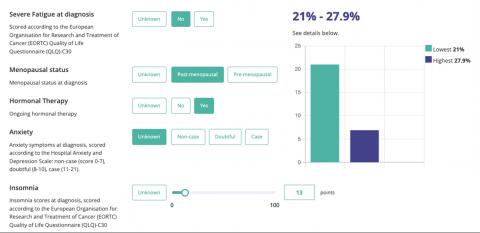
Intertox: predicting breast cancer toxicities
The Intertox project, which is being led by scientists from the Mathematics and Computer Science Laboratory for Complexity and Systems (MICS – Univ. Paris-Saclay, CentraleSupélec) and the Molecular Predictors and New Targets in Oncology Laboratory (PMNCO – Univ. Paris-Saclay, Institut Gustave Roussy, Inserm), aims to offer breast cancer patients personalised treatment based on their individual characteristics. The goal is to better anticipate the undesirable effects of treatments, which often continue after recovery.
Thanks to medical progress, treatments for the disease of breast cancer are increasingly improving. If it is detected in its early stages, it can be cured in over 80% of cases. However, this recovery often brings with it some after effects. As a result of the aggressive nature of the illness and the treatments used, women experience their quality of life reducing in the years which follow. Tiredness, anxiety, weight gain, pain and depression may persist. These undesirable effects, also known as toxicities, can vary enormously from woman to woman. However, the factors which influence their occurrence are still poorly understood. The Intertox project was created in order to better understand these phenomena.
An interdisciplinary venture bringing together data, medical and human sciences
“The origin of the project dates back to a call for proposals put forward jointly by the DATAIA Institute and the Centre of Human Sciences (MSH) Paris-Saclay,” remembers Paul-Henry Cournède, a researcher at the Mathematics and Computer Science Laboratory for Complexity and Systems (MICS) and one of the project’s managers. Together with Antonio Di Meglio, a cancer specialist at the Molecular Predictors and New Targets in Oncology Laboratory (PMNCO), and Élise Martin, a post-doctoral researcher at the PMNCO and MSH Paris-Saclay, he wrote the initial outline of the Intertox project. The project, which won the MSH Paris-Saclay Appel à Projets Excellence (Call for Excellence Projects), combines the three researchers’ areas of specialisation (data science, medical sciences and humanities) in an interdisciplinary approach which is being used to better understand and share information about breast cancer toxicities.
Their work is based on data collected from 12,000 French breast cancer patients, known as the Canto cohort. These data include clinical and biological information measured throughout the patients’ illness and recovery, as well as more subjective information, such as their feelings during this period. “One of the aims of Intertox was to successfully put this dataset together and develop a predictive model for toxicities,” explains Antonio di Meglio.
The data were sent to Paul-Henry Cournède at the MICS laboratory in order to process this mass of information. Using artificial intelligence, the researcher developed an algorithm which took into account the heterogeneity of the data. The challenge was to successfully combine clinical and molecular data in order to understand whether the presence of certain genes or proteins is likely to predict the occurrence of toxicities.
Recently, Antonio di Meglio’s team have analysed the risks of experiencing fatigue following treatment for breast cancer. Predisposing factors include pre-existing fatigue at diagnosis, a high body mass index, insomnia, anxiety, pain and smoking. By collecting this information, the team has developed a preliminary predictive tool. The algorithm developed, which adapts to each patient's profile, requires some easily measurable clinical information as input data. It then calculates the probability of suffering from fatigue two or four years after diagnosis (see diagram below).
The collaboration with Paul-Henry Cournède, which started within the framework of the Intertox project, will be used to improve this tool by integrating more precise biological data from the field of proteomics. Knowing the long-term toxicities of a treatment beforehand is essential to better understand the side effects. The goal is to diminish their impact on patients’ quality of life or to target treatments better.
The importance of a qualitative approach to communication
However, once the toxicity has been predicted, a second major problem remains which is how to break the news to patients. Patient care is crucial in cancer care - something of which the members of Intertox are very aware. Élise Martin is leading the qualitative part of this interdisciplinary project. In order to determine how best to communicate the risks of toxicity to patients, the choice was made to give patients a voice. To achieve this, the researcher set up small group interviews (focus groups) of four to eight people made up of patients or members of the caring team. These were either organised online or face-to-face. The aim was to identify patients' expectations regarding how this information should be communicated. When should it be communicated? Should the risk be quantified at the time it is communicated? Should strategies for managing toxicities be given up front?
The task is a difficult one because the risk is not general but individual, and depends on the predisposition of each patient. By repeating the focus groups, the Intertox team could test different scenarios in order to retain the most effective ones. Based on the expectations, obstacles and drivers identified, the team developed communication approaches which were then presented to the participants. “The composition of the groups varied for each session in order to gain the greatest range of opinions and to avoid having people whose opinions had been coloured due to their previous participation,” points out Élise Martin. Software analysis of the discussions brought out the main themes and ideas from these discussions. This was then fed into the project and the best approach would then be deployed in a clinical trial.
The strength of Intertox is combining the different skills of the laboratories at Université Paris-Saclay in order to address breast cancer toxicities in all their aspects, both quantitative and qualitative. “The environment at Université Paris-Saclay offers the opportunity to set up large multidisciplinary projects and increase connections between institutes,” says Paul-Henry Cournède enthusiastically. As the saying goes ‘if you want to go quickly, go alone. If you want to go far, go together’.
Publications:
- Di Meglio A, Havas J, Soldato D, et al. Development and Validation of a Predictive Model of Severe Fatigue After Breast Cancer Diagnosis: Toward a Personalized Framework in Survivorship Care. Journal of Clinical Oncology (2022).
- Di Meglio A, Havas J, Gbenou AS, et al. Dynamics of Long-Term Patient-Reported Quality of Life and Health Behaviors After Adjuvant Breast Cancer Chemotherapy. Journal of Clinical Oncology (2022).
- Martin, E., Di Meglio, A., Menvielle, G. et al. Informing the development of multidisciplinary interventions to help breast cancer patients return to work: a qualitative study. Support Care Cancer (2022).

